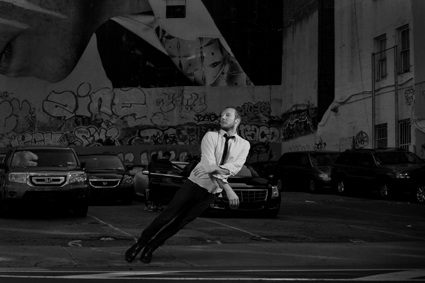 |
Stone/Castro, Blackout image by Rodeo |
Early in our interview Paulo Castro, Stone’s long-time collaborator and partner, confirms this darkly: “When the planes hit, Jo told me, people were looking up into the sky for more of them. Ghosts, sleepwalkers, somnambulists full of dust…”
The company’s latest production, Blackout, has as its point of departure not the specific events of that day, but the feelings of collapse and dislocation which suffuse the minutes, hours and days following cataclysmic events. Says Castro, “Blackout is about the state of loss of control, and about the cycle of building and destroying, destroying and building, that is the world in which we live; September 11, East Timor, the revolution in my own country…”
The revolution to which Castro refers is the 1974 military coup in Lisbon during which no shots were fired. The Estado Novo, Western Europe’s longest surviving authoritarian regime, collapsed, as peaceful protestors stuffed the gun barrels of soldiers’ rifles with cravos (red carnations). The post-revolution years were marked by democratising change and the dissolution of Portugal’s colonial empire, but Castro tells me the spirit of the revolution—of 25 April—penetrated deeply into the generation that grew up in its shadow. “We were all Pussy Riots,” says Castro of this time. “The theatre we were making in bunkers in Portugal in the 1990s was very political, anarchic and left-wing. It was a visceral and experimental world.”
Blackout, Castro tells me, will be less didactic: “It is a response to, not a play about 9/11. It will not be polemical in the way some of my earlier work was. We want to let people think.” Castro, by way of explanation, cites the work of German visual artist Gerhard Richter, whose 2005 painting, titled September, depicts the planes crashing into the World Trade Centre. Immediately searching online I find the painting is surprisingly small, but otherwise entirely characteristic of Richter’s work: photorealistic, but heavily distorted by the artist’s trademark ‘blur,’ an effect achieved by aggressively wiping a brush or sponge across the wet paintwork. Critic Robert Storr called September ‘anti-ideological,’ an attempt to decodify the imagery of 9/11 by disrupting the overfamiliar filmed and photographed representations of the towers’ collapse. It strikes me that Castro’s intentions with Blackout are analogous.
“More abstract that concrete, Blackout takes place on a metaphorical boat,” says Castro, “on which there is a catastrophic power failure. A wedding party is interrupted and suddenly the guests are exposed as frauds, people who all along had been pretending to be someone or something they were not.” Castro cites Lars von Trier’s 2011 apocalyptic drama Melancholia as an influence. That film, like Blackout, features a wedding that is disrupted by a catastrophic event, the narrative function of which is to interrogate extremities of human psychology rather than to anatomise disaster.
I ask Castro about the form Blackout will take, and he describes an approach that is fluid, multidisciplinary and improvisational: “We play within an extremely open space. In rehearsal with a combination of Australian and Portuguese dancers and actors we might attempt five versions of the same scene. Our work is a marriage of everything—choreography, theatre, visual image and soundscape.”
Aesthetically, according to the production’s press release, Blackout will use “blurriness and timewarp” in order to “take naturalistic scenes into a place that shifts between focus and distortion.” I pore over this sentence as Castro speaks, the connection between these words and Richter’s paintings clarifying. But before I’m able to raise the point, Castro obliquely confirms it: “Each moment is not exactly what you are seeing. As in a catastrophe, time seems to slow down and speed up in unexpected ways.” Neuroscientists, I discover later, refer to the phenomenon as ‘mind time,’ a cognitive reality generated by perhaps the most emblematic emotion of the post-9/11 era, fear.
The project is as provocative as any Stone/Castro has devised but Castro, in bringing our conversation to a close, says: “I’m not worried. I’ve worked in Sydney and Melbourne before, but Adelaide is a little bit special. It is a city thirsty for surprises.”
In addition to Jo Stone, the multinational cast includes Australian-based performers Vincent Crowley, Alisdair Macindoe, Nathan O’Keefe, Larissa McGowan and Stephen Sheehan, and from Portugal John Romao. Blackout’s key creatives include Portuguese lighting designer Daniel Worm and South Australian-based designers Sascha Budimski (sound) and Morag Cook (set and costumes).
2014 Adelaide Festival, Stone/Castro, Blackout, AC Arts Main Theatre, Adelaide, 3-9 March
RealTime issue #119 Feb-March 2014 pg. 40
© Ben Brooker; for permission to reproduce apply to [email protected]








 back
back